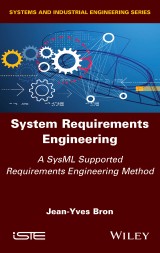Details

System Requirements Engineering
A SysML Supported Requirements Engineering Method1. Aufl.
|
139,99 € |
|
| Verlag: | Wiley |
| Format: | EPUB |
| Veröffentl.: | 16.07.2020 |
| ISBN/EAN: | 9781119751540 |
| Sprache: | englisch |
| Anzahl Seiten: | 224 |
DRM-geschütztes eBook, Sie benötigen z.B. Adobe Digital Editions und eine Adobe ID zum Lesen.
Beschreibungen
The book deals with requirements engineering in the context of System Engineering. He proposes a method to guide this activity engineering. The method is supported by the SysML modeling language. A first chapter aims to present the context and the associated definitions, to position the requirements engineering in the processes system engineering, to define the modeling and its contributions, and to make the link with the management of IS projects. The second chapter is devoted to the proposed method for implementing the requirements engineering subprocesses. Each of the 8 activities the component is first described before specifying how the SysML language can be exploited to achieve it effectively. Proposal for a book Please fill out the questionnaire below and send it back to Chantal Menascé: c.menasce@iste.co.uk The 3rd chapter is an application of the method to define the needs of the stakeholders of a system. The example is built on the basis of the RobAFIS'2018 competition. The 4th chapter continues the application of the method in the continuity of the IS processes to define the requirements of the same system. The appendices present at the same time a toolbox to realize the engineering of the requirements but also the complete results of engineering in Chapters 3 and 4.
<p>Foreword ix</p> <p>Preface xiii</p> <p><b>Part 1. Requirements Engineering </b><b>1</b></p> <p><b>Chapter 1. The Requirements Engineering Process </b><b>3</b></p> <p>1.1. Background and main definitions 3</p> <p>1.2. Requirements engineering process 10</p> <p>1.2.1. Requirements engineering and ISO 15288 processes 11</p> <p>1.2.2. Requirements engineering and ISO 29110 processes 14</p> <p>1.2.3. Problem versus solution 18</p> <p>1.3. Requirements engineering process and modeling 19</p> <p>1.4. Engineering processes and project management 26</p> <p><b>Chapter 2. A Method for Requirements Engineering </b><b>31</b></p> <p>2.1. Proposal of a requirements engineering method 31</p> <p>2.1.1. Requirement diagram 36</p> <p>2.1.2. Block definition diagram 38</p> <p>2.1.3. Use case diagram 38</p> <p>2.1.4. State machine diagram 39</p> <p>2.1.5. Sequence diagram 39</p> <p>2.1.6. Activity diagram 40</p> <p>2.2. Define the system framework 40</p> <p>2.2.1. Goal 40</p> <p>2.2.2. Define the system framework using SysML 41</p> <p>2.2.3. Systematization and verification 43</p> <p>2.3. Define the system life cycle 43</p> <p>2.3.1. Goal 43</p> <p>2.3.2. Define the system life cycle using SysML 44</p> <p>2.3.3. Systematization and verification 45</p> <p>2.4. Define contexts45</p> <p>2.4.1. Goal 45</p> <p>2.4.2. Define contexts using SysML 45</p> <p>2.4.3. Systematization and verification 47</p> <p>2.5. Define uses 47</p> <p>2.5.1. Goal 47</p> <p>2.5.2. Define uses using SysML 49</p> <p>2.5.3. Systematization and verification 52</p> <p>2.6. Describe the use scenarios 53</p> <p>2.6.1. Goal 53</p> <p>2.6.2. Describe the use scenarios using SysML 53</p> <p>2.6.3. Systematization and verification 62</p> <p>2.7. Define functional requirements 62</p> <p>2.7.1. Goal 62</p> <p>2.7.2. Define functional requirements using SysML 65</p> <p>2.7.3. Systematization and verification 67</p> <p>2.8. Define non-functional requirements 67</p> <p>2.8.1. Goal 67</p> <p>2.8.2. Define non-functional requirements using SysML 68</p> <p>2.8.3. Systematization and verification 70</p> <p>2.9. Ensure traceability 72</p> <p>2.9.1. Goal 72</p> <p>2.9.2. Ensure traceability using SysML 72</p> <p>2.9.3. Systematization and verification 75</p> <p>2.10. Conclusion 75</p> <p><b>Part 2. Case Study, Application of the Method </b><b>77</b></p> <p><b>Chapter 3. Definition of Stakeholders’ Needs </b><b>79</b></p> <p>3.1. Case study 79</p> <p>3.1.1. Context of the case study 80</p> <p>3.1.2. Structure of the SysML project 81</p> <p>3.1.3. Presentation of the results 84</p> <p>3.2. Definition of needs 85</p> <p>3.2.1. Define the system framework 85</p> <p>3.2.2. Define the system life cycle 86</p> <p>3.2.3. Define contexts 87</p> <p>3.2.4. Define uses 89</p> <p>3.2.5. Describe the use scenarios 92</p> <p>3.2.6. Define functional requirements 92</p> <p>3.2.7. Define non-functional requirements 95</p> <p>3.2.8. Ensure traceability 95</p> <p>3.3. Stakeholder needs definition documents 98</p> <p>3.3.1. Use a document template 98</p> <p>3.3.2. Use a list of needs 119</p> <p><b>Chapter 4. System Requirements Engineering </b><b>125</b></p> <p>4.1. Case study 125</p> <p>4.1.1. Structure of the SysML project 125</p> <p>4.1.2. Presentation of the results 126</p> <p>4.2. Definition of system requirements 126</p> <p>4.2.1. Define the system framework 126</p> <p>4.2.2. Define the system life cycle 127</p> <p>4.2.3. Define contexts 127</p> <p>4.2.4. Define uses 128</p> <p>4.2.5. Describe the use scenarios 132</p> <p>4.2.6. Define functional requirements 135</p> <p>4.2.7. Define non-functional requirements 136</p> <p>4.2.8. Ensure traceability 136</p> <p>4.3. System requirements analysis document 139</p> <p>4.4. Requirements management 161</p> <p>4.4.1. Fundamental elements 162</p> <p>4.4.2. Management workflows 168</p> <p>4.4.3. Use in student projects 173</p> <p><b>Chapter 5. Integration with Other Methods </b><b>175</b></p> <p>5.1. Context 175</p> <p>5.2. Integration with the Harmony SE method 175</p> <p>5.2.1. Modification of the project structure 176</p> <p>5.2.2. The Harmony SE method and requirements engineering 176</p> <p>5.2.3. Definition of stakeholders’ needs 178</p> <p>5.2.4. Analysis of system requirements 179</p> <p>5.2.5. Conclusion 180</p> <p>5.3. Integration with the Arcadia method 180</p> <p>5.3.1. The Arcadia method and requirements engineering 181</p> <p>5.3.2. Definition of stakeholders’ needs 182</p> <p>5.3.3. Analysis of system requirements 183</p> <p>5.3.4. Conclusion 185</p> <p>5.4. Integration with the CESAM method 186</p> <p>5.4.1. The CESAM method and requirements engineering 186</p> <p>5.4.2. Definition of stakeholders’ needs 187</p> <p>5.4.3. Analysis of system requirements 189</p> <p>5.4.4. Conclusion 189</p> <p>References 191</p> <p>Index 195</p>
Jean-Yves BRON: University of Lorraine


















